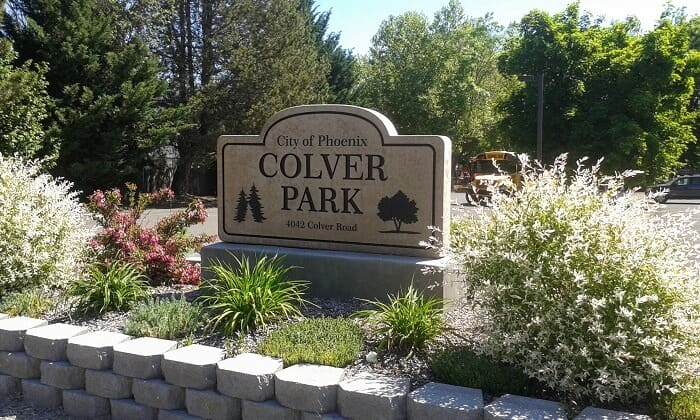Community Gems: From Gold and Gasburg

How many people know that Phoenix, Oregon was originally called Gasburg? Did you know that there was a civil war camp in the city? Or that the settlers found gold in Anderson and Coleman creeks? According to local historian Dorothy Cotton, Phoenix has “quite a bit of fascinating history.” And the town has certainly come a long ways from a stagecoach stop on the route to Jacksonville. Today, Phoenix has access to I-5, and plans for future development in their PH-5 parcel of land, northeast of Home Depot. With a 4,600-person population, firmly rising from the ashes of the 2020 Almeda Fire, the city of Phoenix has plenty more history to make.
In 1851, the Colvers came to town. They ended up selling off property to other settlers, which is how the town got its start. There was mining activity along Anderson Creek and Coleman Creek, and if you weren’t mining, you were probably working at the mill. There weren’t many women in town, but everyone talked with the cook—a woman they called ‘gassy’ (1850s’ slang for talkative). After nicknaming the town Gasburg, the later 1850s rolled around and the settlers decided they wanted a post office. ‘Gasburg,’ seemed a bit too informal, so they looked around the town’s main street and saw the highly visible building sign for Phoenix Insurance, a branch of the Connecticut-based company. Since there was already a nice sign, why not just call the town Phoenix? In the years that followed, the city grew quickly, but so did the civil war uprisings. Because of tensions between miners in Jacksonville, Camp Baker was set up in Phoenix to keep the peace and to train troops. Camp Stewart was also established during the local wars with the native tribes in the area, and then in 1914, Phoenix resident Marion Towne became the first women legislator in the state.
Even in just the past decade, Phoenix has continued to grow. In order to keep the city from being bypassed, the I-5 access realignment took place, opening the new on and off ramps to drivers in 2016. The completion of this project made Phoenix the first place in the state to have a diverging diamond interstate access pattern. Though initially confusing for some drivers, the new road pattern will make future development easier for the PH-5 and PH-10 land parcels (to the east of I-5). With these, PH-5 most notably, the city of Phoenix plans to create more residential and employment opportunities by attracting businesses and housing developers. As residential reconstruction continues in the rest of the city, and brave businesses reopen their doors two years post-fire, the city of Phoenix has high hopes for a thriving future.
© 1987-2026 SOREDI 100 E Main Street, Suite A • PO Box 4672 • Medford, OR 97501 • Phone: (541) 773-8946
